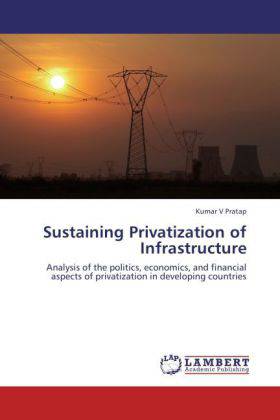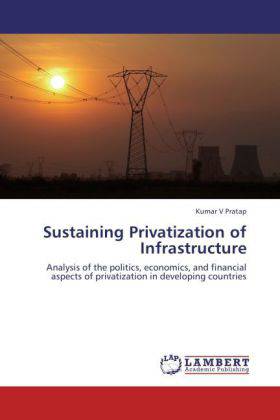
Je cadeautjes zeker op tijd in huis hebben voor de feestdagen? Kom langs in onze winkels en vind het perfecte geschenk!
- Afhalen na 1 uur in een winkel met voorraad
- Gratis thuislevering in België vanaf € 30
- Ruim aanbod met 7 miljoen producten
Je cadeautjes zeker op tijd in huis hebben voor de feestdagen? Kom langs in onze winkels en vind het perfecte geschenk!
- Afhalen na 1 uur in een winkel met voorraad
- Gratis thuislevering in België vanaf € 30
- Ruim aanbod met 7 miljoen producten
Zoeken
Sustaining Privatization of Infrastructure
Analysis of the politics, economics, and financial aspects of privatization in developing countries
Kumar V Pratap
Paperback | Engels
€ 104,45
+ 208 punten
Omschrijving
This book examines the factors associated with sustainable privatization of infrastructure projects. Privatization offers a way for governments to make infrastructure delivery more effective and efficient than exclusively public provision, but often the promise is fraught with peril. The three essays in the book seek to use empirical data and analysis to answer three selected questions regarding sustainable privatization: what causes the private sector to exit from infrastructure projects; do Public-Private Partnerships (PPPs) provide value for money to governments; does privatization lead to benign outcomes. The major conclusions are: project cancellation rates, though rising, are still low - for the most part, the private sector is staying in private infrastructure projects; although trends in cancellation may not be an issue for private infrastructure projects as a whole, it is a concern in the water and sewerage sector; there is value for money to governments from Public-Private Partnerships in infrastructure; privatization leads to significant improvement in profitability, efficiency, and real output of firms, but the impact on employment is negative.
Specificaties
Betrokkenen
- Auteur(s):
- Uitgeverij:
Inhoud
- Aantal bladzijden:
- 236
- Taal:
- Engels
Eigenschappen
- Productcode (EAN):
- 9783847342229
- Verschijningsdatum:
- 21/02/2012
- Uitvoering:
- Paperback
- Afmetingen:
- 152 mm x 229 mm
- Gewicht:
- 349 g

Alleen bij Standaard Boekhandel
+ 208 punten op je klantenkaart van Standaard Boekhandel
Beoordelingen
We publiceren alleen reviews die voldoen aan de voorwaarden voor reviews. Bekijk onze voorwaarden voor reviews.









